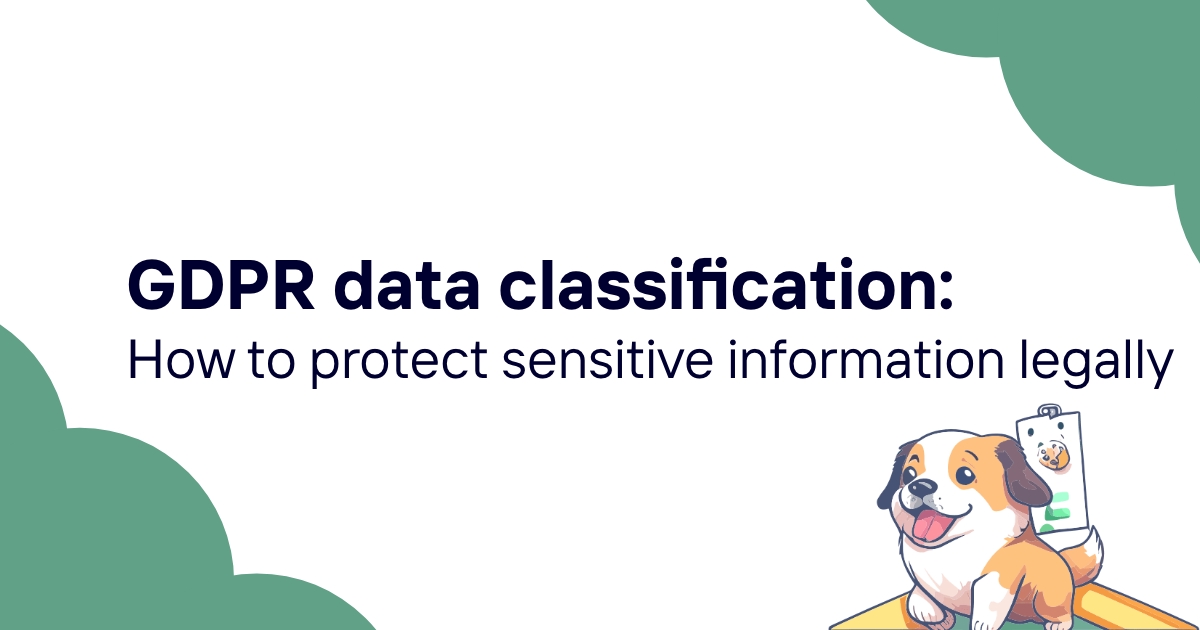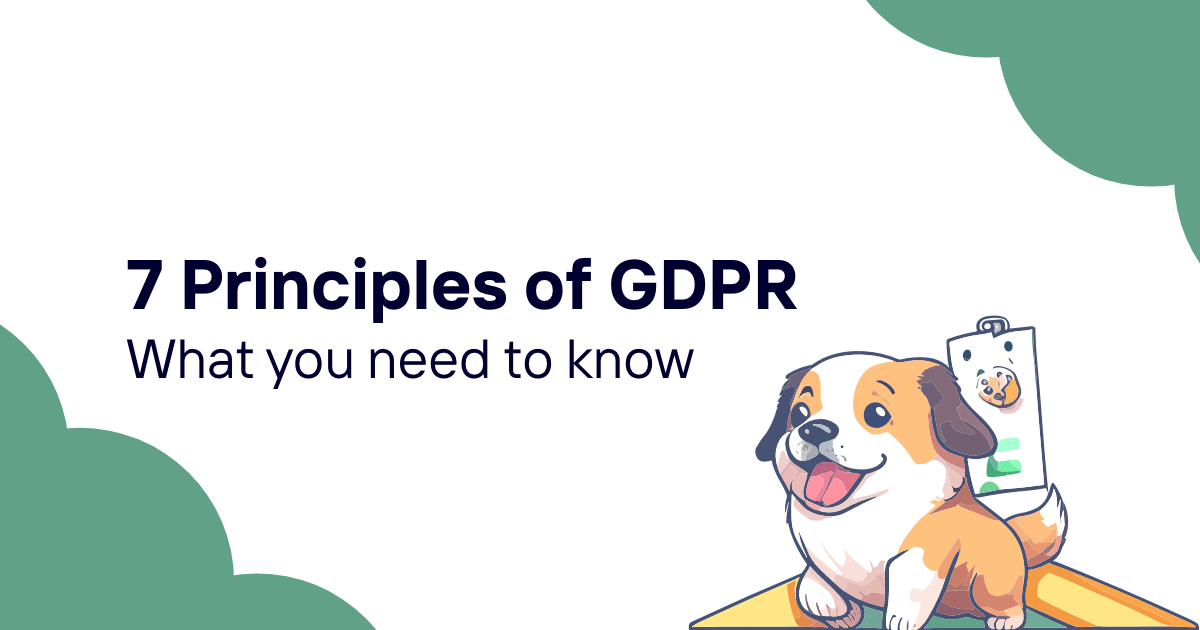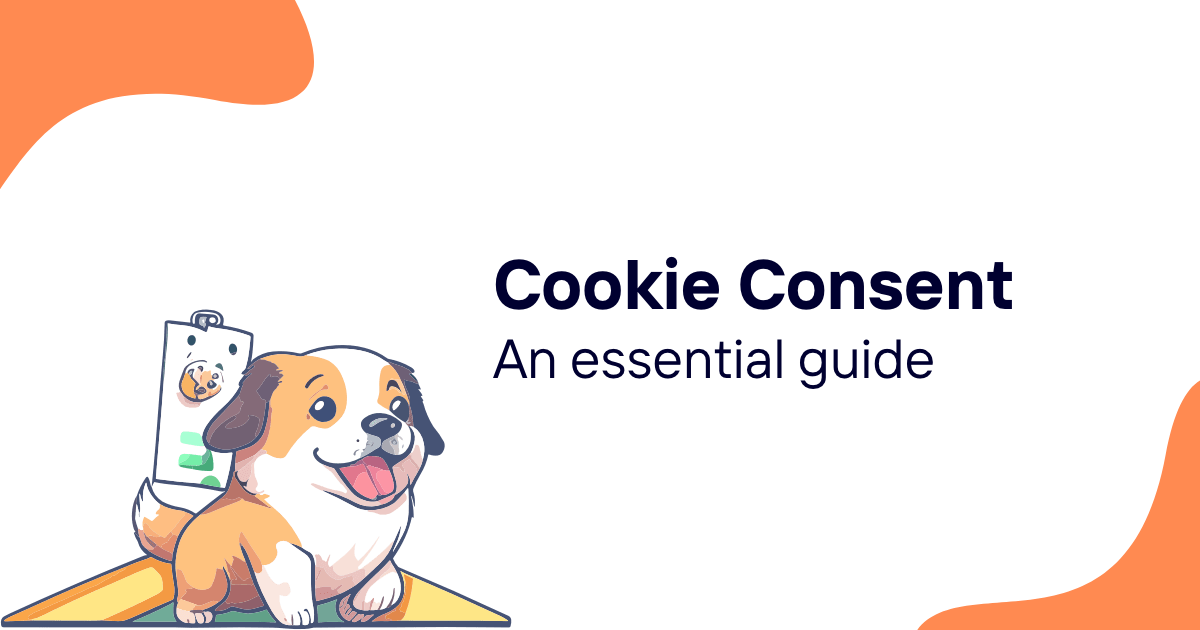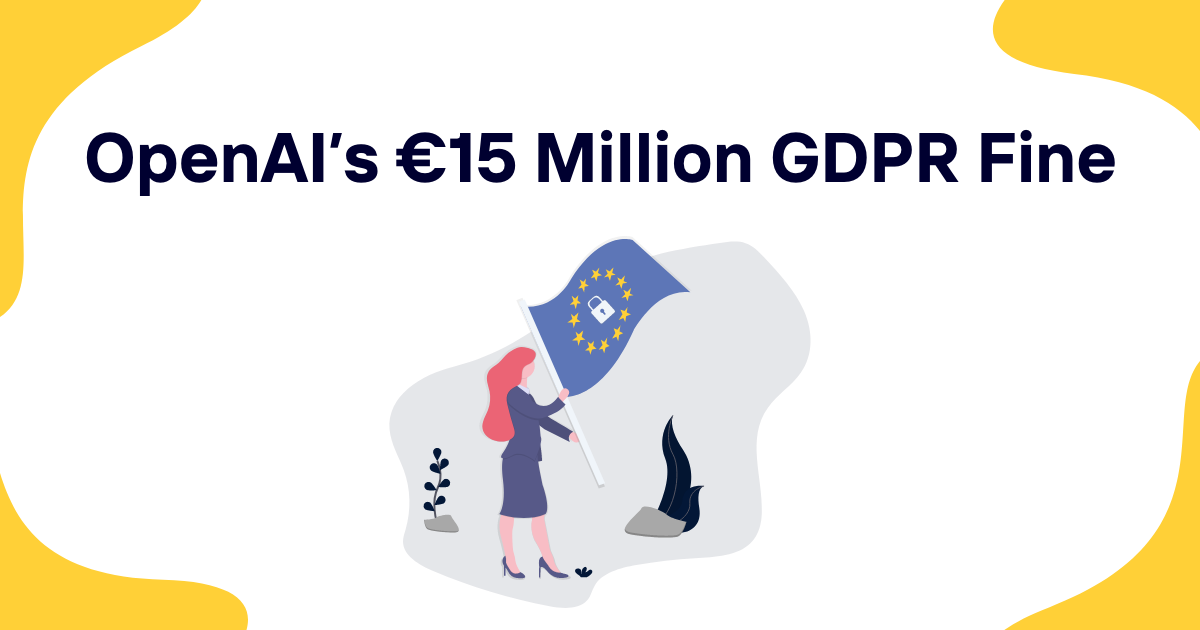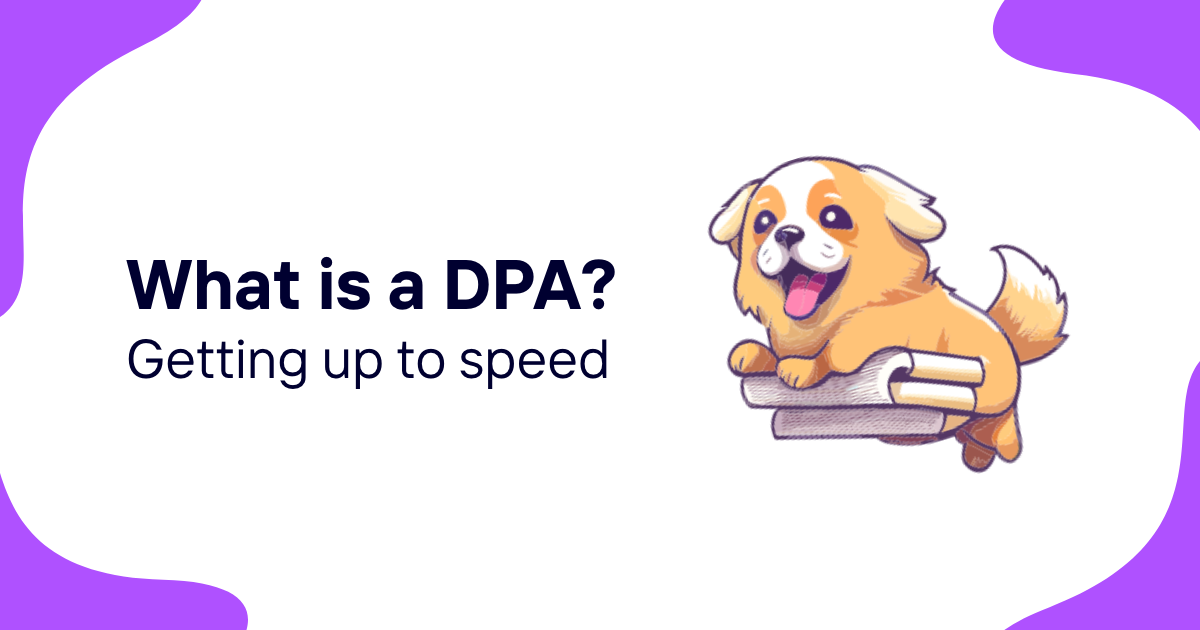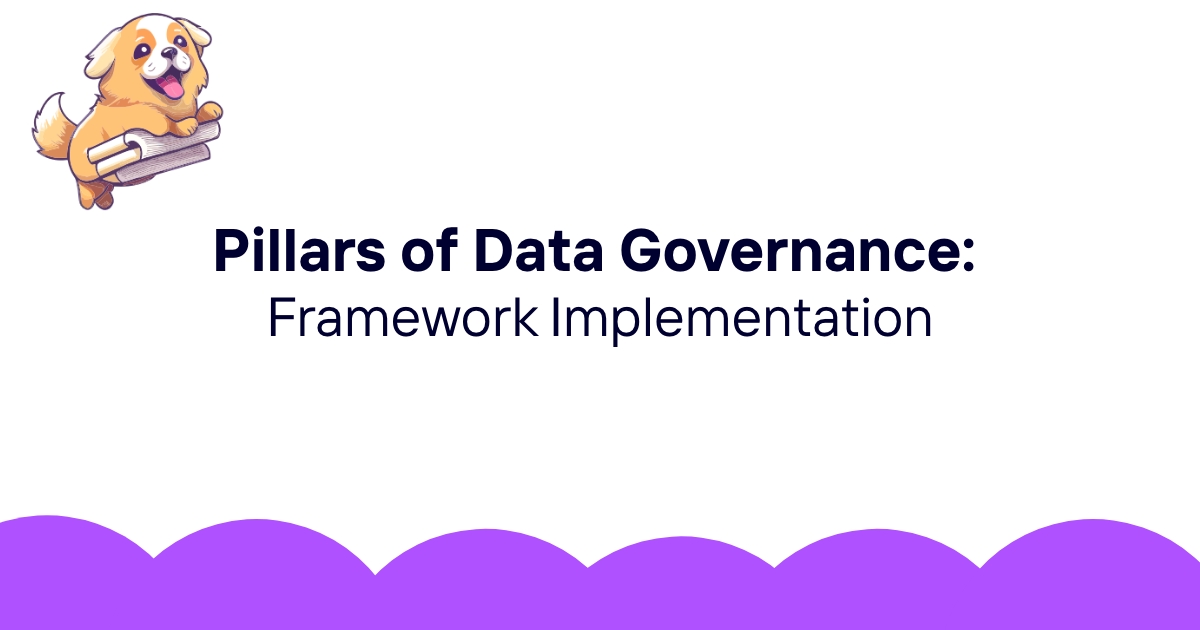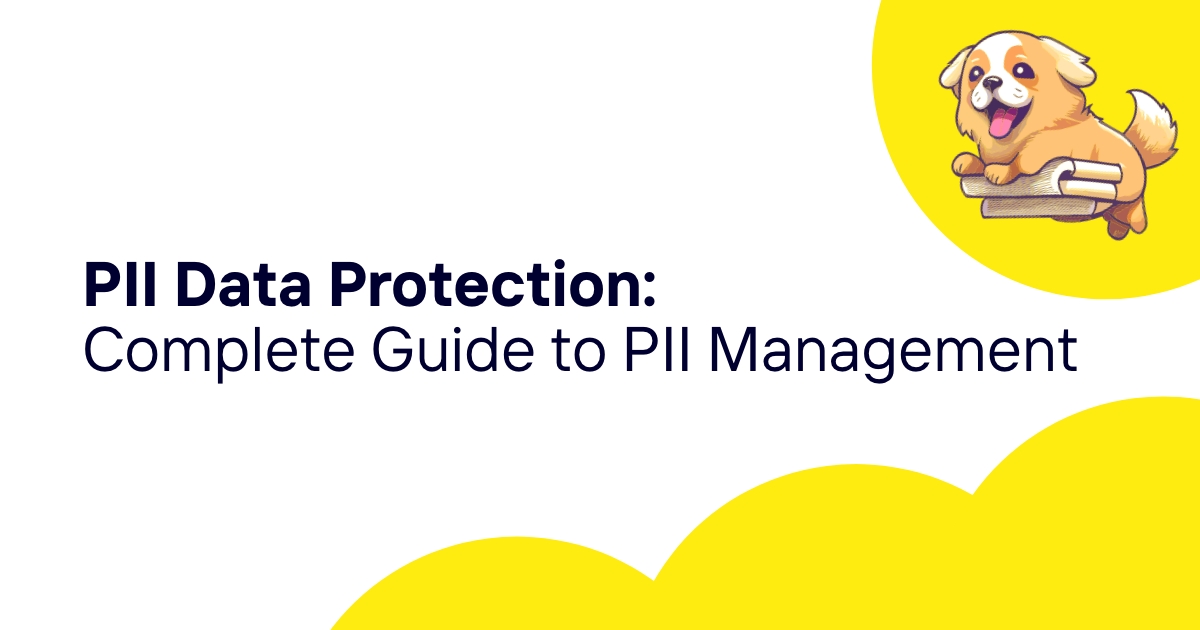Data protection officers wake up in cold sweats thinking about unclassified data scattered across their organizations. And rightfully so. Under GDPR, not knowing what data you have is like driving blindfolded on a highway—you're bound to crash eventually.
GDPR data classification isn't just about organizing files in neat folders. It's the foundation that determines whether your organization faces minor compliance hiccups or massive €20 million fines. Yet many businesses treat it as an afterthought, cramming it into their compliance programs at the last minute.
Let's fix that.
Table of contents
- What is GDPR data classification
- Why GDPR makes data classification mandatory
- The four levels of data classification
- How GDPR defines personal data
- Special categories under GDPR
- Building your data classification framework
- Implementation best practices
- Common classification mistakes
- Automation and technology solutions
- Data classification in practice
- Integration with other compliance frameworks
- Measuring classification success
- Future-proofing your approach
What is GDPR data classification
GDPR data classification is the systematic process of categorizing information based on its sensitivity level and regulatory requirements under the General Data Protection Regulation. Think of it as creating a filing system where each piece of data gets labeled according to how much protection it needs.
But here's where it gets interesting. Unlike traditional data classification schemes that focus primarily on business sensitivity, GDPR classification centers on individual privacy rights. Your marketing email list containing customer preferences? That's personal data requiring specific protections. The public press releases on your website? Still data, but with different requirements.
The regulation doesn't explicitly mandate specific classification levels. Instead, it requires organizations to understand what personal data they process and apply appropriate safeguards. This flexibility sounds helpful until you realize you need to make dozens of nuanced decisions about data handling.
Organizations typically adapt the standard four-tier classification system to meet GDPR requirements:
- Public data: Information freely available without privacy concerns
- Internal data: Business information with minimal privacy impact
- Confidential data: Personal data requiring enhanced protection
- Restricted data: Special categories and highly sensitive personal information
Each level triggers different obligations under GDPR. Public data might require basic transparency measures, while restricted data demands explicit consent, data protection impact assessments, and additional security controls.
Why GDPR makes data classification mandatory
Article 5 of GDPR establishes data protection principles that make classification unavoidable. You cannot demonstrate lawfulness, fairness, and transparency without knowing what data you have. Period.
The accountability principle goes further. Organizations must prove compliance, not just claim it. When regulators knock on your door (and they will), saying "we think we're compliant" won't cut it. They want documentation showing exactly what personal data you process, how you protect it, and why your approach meets GDPR standards.
Data subject rights create another layer of complexity. How can you respond to access requests if you don't know where personal data lives? How do you ensure accurate deletion without proper classification? These rights become impossible to fulfill without systematic data organization.
Risk-based compliance represents the heart of GDPR's approach. The regulation recognizes that not all data carries equal risk. Processing basic contact information differs significantly from handling biometric data. Classification allows you to calibrate your compliance efforts, applying stronger protections where risks run higher.
The financial stakes make classification even more critical. GDPR fines can reach 4% of global annual turnover or €20 million, whichever is higher. These penalties often result from organizations losing control of personal data—exactly what proper classification prevents.
The four levels of data classification
Public data
Public data includes information already in the public domain or intended for public consumption. Marketing materials, press releases, published research, and publicly available contact information fall into this category.
Don't assume public data escapes GDPR scrutiny entirely. Even public information can constitute personal data if it relates to identified individuals. That customer testimonial on your website? Still personal data, even though it's public.
Consider these scenarios:
- Company blog posts: Generally public, but author information might be personal data
- Public directories: Information may be public, but your use could still require legal basis
- Social media content: Public posts can become personal data when you process them
Internal data
Internal data serves legitimate business purposes but isn't intended for external sharing. Employee handbooks, internal communications, business strategies, and operational procedures typically receive this classification.
The GDPR angle becomes relevant when internal data contains personal information. Employee records, internal communications mentioning customers, or business documents with personal identifiers all require privacy protections.
Examples include:
- Internal newsletters mentioning staff achievements
- Business plans referencing customer data
- Meeting minutes containing personal information
- Training materials with case studies using real data
Confidential data
This category captures most personal data processed under GDPR. Customer databases, employee records, financial information, and health data require enhanced protection measures.
Confidential classification triggers specific GDPR obligations:
- Legal basis: Clear justification for processing
- Purpose limitation: Use only for stated purposes
- Data minimization: Collect only necessary information
- Security measures: Technical and organizational safeguards
- Retention limits: Clear deletion timelines
Common examples:
- Customer relationship management systems
- Human resources databases
- Financial transaction records
- Marketing automation platforms
- Support ticket systems with personal information
Restricted data
Restricted data includes GDPR's "special categories" and other highly sensitive information. Biometric data, health records, political opinions, religious beliefs, and trade union membership require the highest protection levels.
Processing restricted data demands:
- Explicit consent or other specific legal conditions
- Data protection impact assessments for high-risk processing
- Enhanced security measures including encryption
- Strict access controls limiting who can view information
- Regular auditing and monitoring procedures
Examples include:
- Biometric authentication systems
- Medical records and health applications
- Background check information
- Genetic data for any purpose
- Children's personal data
How GDPR defines personal data
GDPR Article 4 defines personal data as "any information relating to an identified or identifiable natural person." This definition creates a broad net that catches more information than many organizations expect.
The "identifiable" aspect proves particularly tricky. Data doesn't need to directly name someone to qualify as personal data. Indirect identifiers like IP addresses, device IDs, location data, or even behavioral patterns can make someone identifiable.
Direct identifiers
These obviously identify individuals:
- Names and aliases
- Email addresses
- Phone numbers
- Physical addresses
- Social security numbers
- Passport numbers
- Driver's license numbers
Indirect identifiers
These can identify individuals when combined with other information:
- IP addresses
- Cookie identifiers
- Device fingerprints
- Location coordinates
- Timestamps combined with other data
- Employee ID numbers
- Customer account numbers
Pseudonymized data
GDPR recognizes pseudonymization as a protective measure, but pseudonymized data remains personal data. The difference matters for security requirements and risk assessments, but privacy obligations still apply.
Anonymous data
Truly anonymous data falls outside GDPR scope. But achieving genuine anonymization proves difficult. Most "anonymized" datasets retain enough information to re-identify individuals with additional data sources.
Special categories under GDPR
Article 9 establishes special categories requiring enhanced protection. These data types carry higher risks for individuals and trigger stricter processing requirements.
Health data
Any information about physical or mental health, including:
- Medical records and diagnoses
- Prescription information
- Health insurance claims
- Fitness tracker data
- Mental health counseling records
Biometric data
Information used for unique identification:
- Fingerprints and palm prints
- Facial recognition data
- Voice patterns
- DNA profiles
- Retina scans
Political opinions and activities
Information revealing political beliefs:
- Party memberships
- Voting records
- Political donations
- Campaign participation
- Political survey responses
Religious or philosophical beliefs
Data indicating personal convictions:
- Religious affiliations
- Philosophical society memberships
- Dietary restrictions indicating beliefs
- Educational institution choices revealing beliefs
Trade union membership
Information about labor organization participation:
- Union membership records
- Collective bargaining participation
- Union dues payments
- Strike participation records
Building your data classification framework
Creating an effective classification system requires balancing thoroughness with practicality. Start by mapping your current data landscape, then build classification rules that your team can actually follow.
Step 1: Data discovery and inventory
You can't classify what you don't know exists. Data discovery tools help locate personal information across systems, but manual review remains necessary for context and accuracy.
Focus on these high-priority areas:
- Customer-facing systems like CRM platforms
- Human resources databases with employee information
- Marketing tools containing prospect and customer data
- Financial systems with payment and billing information
- Support platforms with customer communications
Step 2: Define classification criteria
Establish clear rules for each classification level. Avoid vague language that creates confusion during implementation.
Consider these factors:
- GDPR applicability: Does the regulation cover this data?
- Special category status: Are heightened protections required?
- Individual impact: What harm could inappropriate disclosure cause?
- Business sensitivity: How would unauthorized access affect operations?
- Regulatory requirements: Do other regulations apply?
Step 3: Create decision trees
Decision trees help staff classify data consistently. Visual flowcharts work better than lengthy written procedures.
Start with these questions:
- Does this data relate to an identifiable person?
- Is this person an EU resident or in the EU?
- Does the data fall into special categories?
- What would be the impact of unauthorized disclosure?
- Are there other regulatory requirements?
Step 4: Develop handling procedures
Each classification level needs specific handling procedures covering:
- Access controls: Who can view and modify data
- Storage requirements: Where and how to store information
- Transmission rules: How to share data securely
- Retention periods: How long to keep information
- Deletion procedures: How and when to destroy data
Implementation best practices
Theory meets reality during implementation. Even the best-designed classification system fails without proper execution.
Start small and scale
Don't attempt to classify everything simultaneously. Choose one high-risk system or data type, perfect your approach, then expand gradually.
The pilot approach offers several advantages:
- Identifies gaps in your classification framework
- Tests procedures before full implementation
- Builds expertise within your team
- Demonstrates value to stakeholders
- Allows refinement based on real experience
Train your team properly
Classification accuracy depends on user understanding. Generic training programs rarely work. Customize training for different roles and responsibilities.
Effective training covers:
- GDPR basics relevant to their work
- Classification criteria with real examples
- Decision-making processes for edge cases
- Common mistakes and how to avoid them
- Tools and procedures they'll use daily
Build classification into workflows
The best classification system integrates seamlessly into existing business processes. Staff shouldn't need separate tools or extensive additional steps.
Integration opportunities:
- Data entry forms with automatic classification prompts
- Email systems with classification tags
- Document management with mandatory labeling
- Database design with built-in data categories
- API endpoints that require classification metadata
Create feedback loops
Classification accuracy improves through continuous refinement. Establish mechanisms for identifying and correcting mistakes.
Feedback mechanisms include:
- Regular audits of classified data
- User reporting of classification errors
- Automated checks for consistency
- Expert review of edge cases
- Regular updates to classification rules
Common classification mistakes
Experience reveals patterns in classification errors. Learning from others' mistakes saves time and reduces compliance risks.
Over-classifying everything as restricted
The temptation to classify everything at the highest level seems safe but creates operational problems. Restricted classification requires extensive security controls that may be unnecessary for lower-risk data.
Over-classification leads to:
- Excessive compliance costs for low-risk data
- Operational inefficiency from unnecessary restrictions
- User frustration with cumbersome procedures
- Reduced productivity from access barriers
- Classification fatigue causing users to ignore the system
Under-estimating personal data scope
The opposite mistake—failing to recognize personal data—creates significant GDPR risks. Organizations often miss indirect identifiers or data combinations that can identify individuals.
Common oversights include:
- IP addresses combined with timestamps
- Device fingerprints in analytics data
- Behavioral patterns that reveal identity
- Location data from mobile applications
- Cross-system correlations enabling identification
Ignoring data combinations
Individual data elements might seem harmless, but combinations can create privacy risks. A customer's purchase history plus location data plus demographic information paints a detailed personal picture.
Risk assessment should consider:
- Data linkability across systems
- Inference possibilities from combined datasets
- Re-identification risks with external data sources
- Profiling potential for decision-making
- Discrimination risks from algorithmic processing
Neglecting data lifecycle
Classification requirements change throughout data lifecycle phases. Information that starts as public might become confidential through additional processing or combination with other data.
Lifecycle considerations:
- Collection: Initial classification based on data source
- Processing: Updates for derived or enriched information
- Storage: Long-term classification maintenance
- Sharing: Classification impact on recipients
- Deletion: Final classification before destruction
Automation and technology solutions
Manual classification becomes impossible as data volumes grow. Automated tools can handle much of the work, but human oversight remains critical for accuracy and context.
Machine learning approaches
Modern classification tools use machine learning to identify patterns and classify data automatically. These systems learn from training data to recognize different information types.
ML classification advantages:
- Scale handling: Process massive datasets efficiently
- Pattern recognition: Identify complex data relationships
- Consistency: Apply rules uniformly across systems
- Speed: Classify data in real-time or near real-time
- Adaptability: Improve accuracy through learning
Natural language processing
NLP techniques excel at classifying unstructured text data like emails, documents, and support tickets. These tools can identify personal information within free-form text.
NLP applications include:
- Email classification for privacy compliance
- Document analysis for personal data discovery
- Chat log processing for customer service data
- Survey response analysis for research data
- Social media content classification
Integration challenges
Automated classification requires integration with existing systems and workflows. Legacy applications may lack APIs or classification metadata capabilities.
Common integration issues:
- Legacy system limitations preventing metadata storage
- Data format inconsistencies across applications
- Real-time processing requirements for high-volume systems
- Multi-system data flows requiring consistent classification
- Change management for new classification procedures
Human oversight requirements
Automation handles routine classification tasks, but human expertise remains necessary for:
- Context interpretation that machines miss
- Edge case decisions requiring judgment
- Legal interpretation of regulatory requirements
- Business impact assessment for classification changes
- Quality assurance of automated results
Data classification in practice
Real-world classification scenarios illustrate how principles translate into practical decisions.
Customer relationship management
CRM systems contain diverse data types requiring different classification levels:
- Contact information: Name, email, phone - Confidential level
- Company details: Public information about customer's business - Internal level
- Purchase history: Transaction records and preferences - Confidential level
- Communication logs: Sales calls and email exchanges - Confidential level
- Credit information: Payment terms and financial data - Restricted level
Classification decisions impact system access controls, data retention policies, and security measures.
Marketing automation platforms
Marketing systems process large volumes of personal data for campaign targeting:
- Email lists: Subscriber contact information - Confidential level
- Behavioral tracking: Website visits and interactions - Confidential level
- Demographic data: Age, location, interests - Confidential level
- Preference centers: Communication preferences - Confidential level
- A/B testing data: Response rates and engagement metrics - Internal level
Special attention to consent management and opt-out mechanisms becomes critical.
Human resources systems
Employee data requires careful classification considering sensitivity and legal requirements:
- Basic profile: Name, job title, department - Internal level
- Contact details: Personal email, phone, address - Confidential level
- Performance data: Reviews, ratings, development plans - Restricted level
- Compensation: Salary, benefits, stock options - Restricted level
- Health information: Medical leaves, disability accommodations - Restricted level
Access controls must align with legitimate business needs and role-based permissions.
Support and ticketing systems
Customer support platforms accumulate personal data through problem resolution:
- Ticket metadata: Case numbers, categories, status - Internal level
- Customer identification: Account details, contact information - Confidential level
- Problem descriptions: Technical issues and solutions - Confidential level
- Communication history: Chat logs, email exchanges - Confidential level
- Resolution data: Fix details and follow-up actions - Internal level
Data retention policies must balance customer service quality with privacy obligations.
Integration with other compliance frameworks
GDPR data classification often overlaps with other regulatory requirements. Organizations benefit from harmonizing classification schemes across multiple compliance programs.
ISO 27001 alignment
ISO 27001 information security standards complement GDPR privacy requirements. Both frameworks emphasize risk-based data protection and systematic control implementation.
Alignment opportunities:
- Asset classification matches data sensitivity levels
- Access control procedures support both standards
- Risk assessment methodologies apply to both
- Security monitoring covers privacy and security objectives
- Incident response procedures address both breach types
SOC 2 integration
SOC 2 examinations focus on security, availability, processing integrity, confidentiality, and privacy. GDPR classification supports SOC 2 compliance by demonstrating data handling controls.
Complementary elements:
- Control environment documentation includes classification procedures
- Risk assessment processes consider data sensitivity
- Control activities implement classification-based protections
- Information and communication systems support classification
- Monitoring activities verify classification effectiveness
Industry-specific requirements
Sector regulations often impose additional classification requirements:
Healthcare (HIPAA):
- Protected health information aligns with GDPR special categories
- Minimum necessary principle supports data minimization
- Access controls strengthen both HIPAA and GDPR compliance
Financial services (PCI DSS):
- Cardholder data protection complements GDPR requirements
- Sensitive authentication data receives restricted classification
- Security testing procedures support both standards
Government contracting (CMMC):
- Controlled unclassified information requires enhanced protection
- Federal contract information needs appropriate safeguards
- Supply chain security extends to subcontractor data handling
Measuring classification success
Effective measurement systems track both compliance outcomes and operational efficiency.
Compliance metrics
Track metrics that demonstrate GDPR adherence:
- Data subject request response times: Faster responses indicate better data organization
- Classification accuracy rates: Regular audits measure quality
- Incident resolution speed: Quick containment shows effective controls
- Regulatory examination results: External validation of compliance
- Breach impact limitation: Proper classification reduces harm
Operational indicators
Monitor metrics showing business value:
- Data access request fulfillment: Legitimate business needs met efficiently
- System integration success: Classification supports business processes
- User adoption rates: Staff actively use classification tools
- Cost per data element: Economic efficiency of classification program
- Decision-making speed: Faster risk assessments and business decisions
Risk reduction measures
Quantify risk mitigation through classification:
- Data exposure reduction: Less sensitive data in vulnerable systems
- Incident severity limitation: Better containment of security events
- Regulatory penalty avoidance: Compliance demonstration reduces fines
- Business continuity: Faster recovery from data-related disruptions
- Reputation protection: Proactive privacy measures build trust
Future-proofing your approach
Data classification must evolve with changing technology, regulations, and business needs.
Emerging technologies
New technologies create classification challenges:
Artificial intelligence and machine learning:
- Training data classification affects model development
- Algorithmic decision-making requires data provenance tracking
- Bias detection depends on understanding data characteristics
- Explainable AI needs detailed data lineage information
Internet of Things (IoT):
- Sensor data volume overwhelms manual classification
- Device identifiers create new personal data categories
- Edge computing requires distributed classification decisions
- Real-time processing demands automated classification
Blockchain and distributed systems:
- Immutable records complicate data correction obligations
- Decentralized storage challenges traditional access controls
- Smart contracts automate data processing decisions
- Cross-border transactions require consistent classification
Regulatory evolution
Privacy regulations continue developing globally:
- New jurisdictions adopt GDPR-inspired laws
- Existing regulations receive updates and clarifications
- Sector-specific rules create additional requirements
- Cross-border frameworks emerge for international data transfers
- Enforcement patterns evolve through regulatory experience
Organizational growth
Business expansion affects classification requirements:
- New markets bring different regulatory obligations
- Additional systems require classification integration
- Mergers and acquisitions demand classification harmonization
- Product development creates new data processing scenarios
- Partnership arrangements extend classification requirements
Getting started with ComplyDog
Building a robust GDPR data classification system requires the right combination of expertise, tools, and processes. While organizations can develop classification frameworks manually, compliance software significantly accelerates implementation and reduces ongoing maintenance burden.
ComplyDog provides comprehensive GDPR compliance tools that streamline data classification and automate many routine tasks. The platform helps organizations discover personal data across systems, apply consistent classification rules, and maintain compliance documentation automatically.
Instead of building classification systems from scratch, organizations can focus on their core business while ComplyDog handles the technical complexities of GDPR compliance. The platform's integrated approach connects data classification with other privacy requirements, creating a unified compliance management system.
Ready to simplify your GDPR data classification efforts? Visit ComplyDog.com to learn how automated compliance tools can transform your privacy program from a regulatory burden into a competitive advantage.
